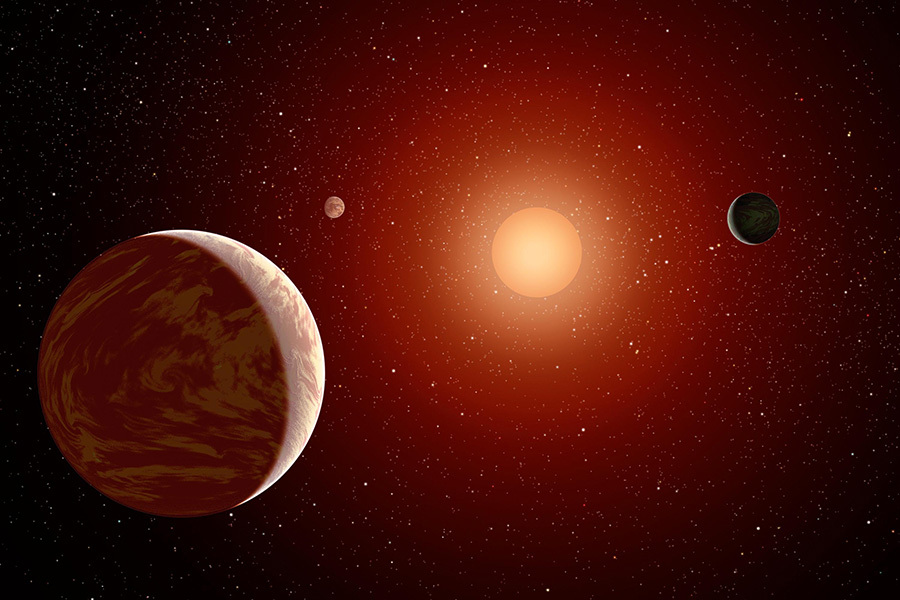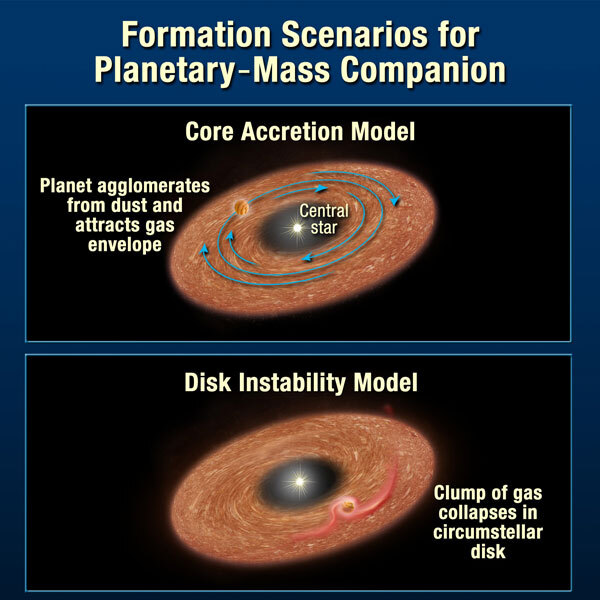12.04.2023
Leading theories say giant planets shouldn’t be able to form around very low-mass stars. But a new study finds that, nevertheless, they do.

Giant planets surround a red dwarf star in this artist's concept.
NASA / JPL-Caltech
In 2019 astronomers found something strange — a gas giant in a very close orbit around a low-mass star, an M dwarf dubbed GJ 3512. The discovery was an anomaly, because there shouldn’t have been enough material around the star to form such a big planet in the first place.
Now, in a new study in the Monthly Notices of the Royal Astronomical Society led by Edward Bryant (University College London), astronomers have identified fifteen possible gas giants orbiting low-mass stars. The 2019 discovery, it appears, is not unique and instead calls standard planetary formation theories into question.
The core accretion model of planet formation has two phases: First, planetesimals collide and stick together, becoming rocky cores the size of a few Earth masses. Then they start to gather large amounts of gas around themselves. This theory works well in simulations of most star systems, including our own. But low-mass stars host similarly low-mass planet-forming disks. So how can they make giant planets?
Astronomers proposed several ideas to explain the existence of GJ 3512b. Maybe the planet wandered in from elsewhere, or maybe it came together via another formation pathway, such as disk instability. In the latter alternative, gas giants form in one go, though this ought to happen farther from the host star. Nevertheless, interesting arguments were put forward to support the idea for this particular case.

This diagram depicts two leading scenarios for planet formation. Core accretion is another name for the cold-start scenario and disk instability is another name for the hot-start scenario.
: NASA / ESA / A. Feild
Bryant’s group, however, showed that the planet isn’t unique. They analyzed data from the Transiting Exoplanet Survey Satellite, including more than 91,000 stars with less than half the Sun’s mass, and identified 15 with giant planets or planet candidates in close orbits. So while the occurrence rate is low — only 0.2% — it’s greater than the null rate astronomers had previously assumed.
Bryant and his team also tried to model the two main formation pathways with the planets in question, but they found that neither worked well to explain how these systems came to be. “Maybe there is a third formation method going on that we don't know about yet,” Bryant speculates. “Or it is one of the main two, but it's operating in extreme circumstances.” There may be several ways that planets could form.
To improve our planetary formation models, we need more data on more planetary systems in different stages of evolution. The observations we have are limited by the methods we use to detect planets, including the radial velocity method, which is good for finding planets around low-mass stars, and the transit method, which works best for planets orbiting close-in to their star. But there are many different kinds of planet systems out there, and we’ll need more and different techniques to find them all.
Martin Schlecker (University of Arizona), who was not part of this study, says that microlensingmight be one solution. “Gravitational microlensing is an exoplanet hunting method made more feasible by instruments like the upcoming Nancy Grace Roman Space Telescope,” he says.
Microlensing relies on the gravitational force of a foreground star, which bends and focuses light coming from a distant background star. If there’s a planet around the foreground star, it will leave a distinct fingerprint in the amplification of the collected light. This method can detect planets orbiting far out from Sun-like stars, and can even find rogue planets that aren’t gravitationally bound to a star at all. It can thus fill in some gaps in the planetary census.
Everyone loves a mystery, and right now astronomers are thrilled that neither core-accretion nor disk instability seems to work in the case of these rare gas giants around tiny stars.
Quelle: Sky & Telescope
